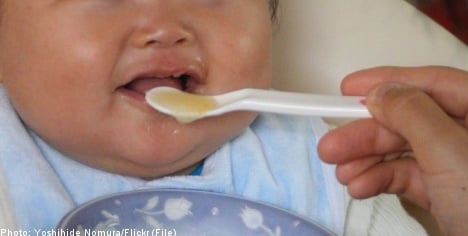According to a statement from the National Food Administration (Livsmedelsverket), the high levels may be due to the raw materials used in the production of the food, or to the fact that the products are enriched with manganese.
The products under analysis include infant formula and porridge.
While the tests were only carried out on a few samples, it’s too early to say that the risk of high levels of the substances applies generally.
Nevertheless, the fact that even one sample of baby food contained high levels of the substances is very serious, according to Emma Halldin Ankarberg, a toxicologist at the Food Administration.
“They aren’t so high that the reach to level of tolerable daily intake. But it’s still inappropriate that they are there. The risk is that small children are more sensitive than adults. When it comes to the levels of arsenic and cadmium, the levels aren’t high enough that one needs to panic,” Halldin Ankarberg told the TT news agency.
The tests, which were carried out by the Institute of Environmental Medicine at Karolinska Institutet, revealed high levels of manganese in infant formula intended for children with allergies. The porridges tested contained high levels of manganese, cadmium, and arsenic.
According to the Food Administration, it was rice-based products that posed the primary problem.
The agency explained that the high levels of manganese, cadmium, and arsenic in porridge were attributable to the raw materials used in its production. But because the tests were only done on one sample per product, it’s not possible to say that all porridge has the same elevated levels.
While cadmium and arsenic are poisonous, which likely comes from the raw materials used to make the baby food, manganese is added to the food an essential nutrient, but can nevertheless be harmful at high levels.
Halldin Ankarberg said that the baby food manufacturers have stayed under approved limits of manganese, but that the National Food Administration wants the European Commission and the European Food Safety Organisation (EFSA) to review the limits.
“We don’t believe that these companies have done anything wrong. But we want them to react to this report. You can’t just shrug it off, but take stock of it,” Jan Sjögren, head of the Food Administration’s inspection division, told TT.
The agency was swamped with calls from worried parents on Thursday morning.
“They understandably wonder what they should feed their children if they might aren’t able to give them infant formula,” said Sjögren.
The agency is now gathering data in order to get a better understanding of the problem as well as what measures may need to be taken and additional testing is currently underway.
“Currently we don’t know if it can cause adverse health effects, those need to be investigated further. In the meantime we are advising parents to consult their dieticians or doctors when choosing an infant formula with low levels of manganese,” Halldin Ankarberg said in a statement.



 Please whitelist us to continue reading.
Please whitelist us to continue reading.
Member comments